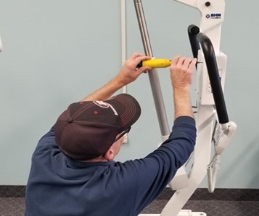
An important part of any safe patient handling program is making sure your equipment and handling tools are safe for use. In order to ensure the safety of the patients being transfer, and to protect the care provider, the equipment must be in proper working order and free from deficiencies. The manufacture of all safe patient handling equipment lays out it’s recommendations on how to schedule an annual inspection and service for your equipment, and identify where common problems can be hidden.
Just like changing your cars oil after so many miles, your patient lift and slings will need a safety inspection after so many lifts. Whether you have a Hoyer, Vancare, or any other manufacture; patient lifts are subjected to strain and can malfunction. A trained and qualified technician should carry out the inspection with specialized testing equipment and examine your equipment by following the manufacturers 25 to 40 written points on the equipment’s inspection list. Having your equipment stamped safe for use should be a crucial part of your facility’s safe patient handling program.
After several hundred patient lifts and countless washes, a sling starts to lose its integrity. Each sling should be inspected before each use, if there are any rips or fraying, it should be taken out of service immediately. The lifts themselves are put under stain from daily use, an inspection can reveal cracked welds, warped boom arms, loose or missing bolts, as well as degraded battery function. Facilities with over head track systems, the track anchors should be secured and tightened. Specialized load testing tools need to be used to test the health of the lifting device, the charging system, safety limit switches, and condition of all parts, and the entire track.
Annual inspections can detect a small problem before it becomes a large one, or results in a patient fall from a malfunction. When problems come as a surprise, the equipment can no longer be used, forcing staff to revert to manual lifting techniques, and an expensive emergency service call may be needed. The comfort of knowing your patients and staff are protected by having equipment stamped with approval that it meets all safety requirements.
Another very important aspect of your facilities yearly inspection is that it should include an evaluation on the safe patient handling equipment on hand, and how it meets your facilities needs. If the staff do not have access to an adequate supply lifts, slings, and other aids, studies have shown that they will instantly resort to previous patient moving techniques. Old techniques that have been shown to cost a facility work hours due to injury, as well as injuries to patients and residents.






